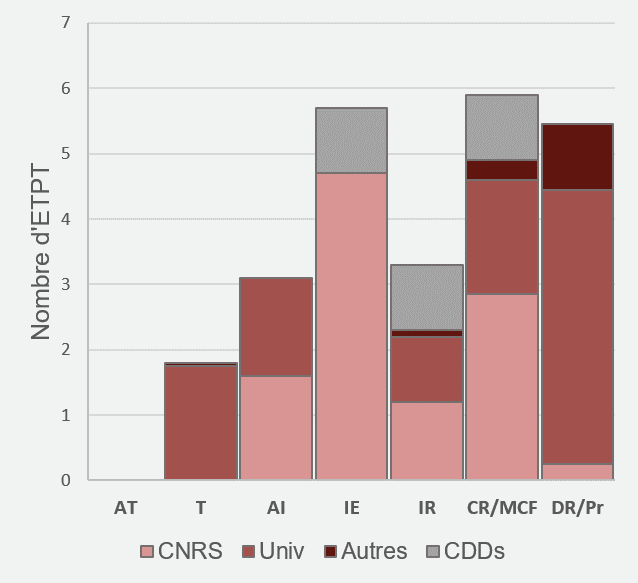Animateur.e.s :
12
plateformes analytiques
7.5
M€ d’équipements
149
k€/an coût de fonctionnement
11.9
ETP IT statutaires
10.4
ETP C/EC statutaires
597
m² de laboratoire
Les instruments du réseau :
Le réseau Gaz Rares regroupe des instruments dédiés à deux grands types d’approches scienti-fiques : (i) l’analyse des gaz rares pour le traçage isotopique et géochimique et (ii) l’analyse des gaz rares et des traces de fission pour la géo-thermo-chronologie. Ce réseau rassemble des instruments aussi différents que des spectromètres de masse pour mesurer l’isotopie et les abondances des gaz rares, et des microscopes optiques pour compter les traces de fissions.
Une grande partie des instruments sur les plate-formes du réseau est dédiée à la géo-thermo-chronologie avec des chronomètres basés sur les systèmes radiochronologiques 40K/40Ar et 40Ar/39Ar (Feldspaths, micas, matrice, glace) et (U-Th-Sm)/4He (apatite, zircon, oxydes). Ces mesures sont mises en œuvre grâce à des spectromètres à secteur magné-tique ou quadripolaires, soit à l’échelle des grains de minéraux, soit in situ à l’intérieur des grains quand les spectromètres sont couplés avec des lasers. Les datations par comptage des traces produites lors de la fission naturelle de l’238U (apatite et zircon) sont souvent mises en œuvre en parallèle par les mêmes équipes. Ces datations nécessitent la mesure com-plémentaire des éléments pères (K, U, Th, Sm) et de l’imagerie amont, qui sont opérées en collaboration avec les autres réseaux de RéGEF, ou par irradiation sur accélérateur pour les traces de fission et 40Ar/39Ar. Basées sur des réactions nucléaires diffé-rentes (spallation et captures), les datations cosmo-géniques sont mises en œuvre par les plateformes spécialisées dans le traçage isotopique, et capables de mesurer les isotopes naturels de l’3He et 21Ne qui sont produits en quantités très faibles.
Le traçage isotopique est mis en œuvre par 3 plateformes. Les gaz rares (He, Ne, Ar, Kr, Xe) sont extraits de minéraux naturels terrestres et extrater-restres (par broyage, fusion ou ablation laser) ou dans différents fluides crustaux (eau, gaz), et l’analyses effectuée sur des spectromètres de masse multi-collection de nouvelle génération.
La distribution sur le territoire et le personnel affecté :
Les données produites :
Le réseau Gaz Rares produit une grande quantité de datations qui permettent de contraindre le calen-drier et les taux des processus géologiques sur notre planète, que ce soit l’âge des roches magmatiques et métamorphiques, la datation des séries sédimen-taires via la téphrochronologie, la vitesse de surrec-tion des chaînes de montagnes via la thermochronologie, la datation pionnière des latérites, des minéralisations, ou encore l’âge des paysages et leurs vitesses d’érosion via la mesure des nucléïdes cosmogéniques.
Les nombreux isotopes fils produits par les diffé-rentes réactions nucléaires sur Terre et dans le sys-tème solaire confèrent aux systèmes isotopiques des gaz rares un pouvoir de traçage très important que ce soit pour reconstruire la formation du système solaire, la différentiation et l’évolution du manteau, l’origine de notre l’atmosphère, la migration des fluides dans la croûte terrestre, ou encore les relations avec les aléas telluriques naturels ou ceux d’origine anthropique.
Organisation et spécificités :
La communauté « gaz rares » regroupe différentes spécificités analytiques et techniques et diffère des autres réseaux de RéGEF quant à la gestion du parc analytique. En effet, peu de groupes ont recours à des contrats de maintenance, et la plupart des laboratoires ont monté leurs propres installations amont pour l’extraction et la purification des gaz
rares. La majorité de ces équipes se sont spécialisées dans le développement et gèrent la maintenance des équipements.
Le coût des instruments est très varié, allant de quelques dizaines de milliers d’euros pour les microscopes traces de fission (30-40 k€), à des centaines de milers d’euros pour les lignes et spectromètres gaz rares (200-300 k€ pour les lignes+ spectromètres quadripolaires à 500-700 k€ pour les lignes + spectromètres à secteur magnétiques). Les spécificités techniques pour chaque type d’analyse ou de datation rendent les instruments du réseau peu flexibles à d’autres type de mesures et les spécialisent vis-à-vis des réglages et protocoles. La plupart des lignes d’extraction et de purification sont des prototypes spécifiques.
Les instruments réalisant des analyses de thermochronologie (gaz rares et traces de fission) sont fédérés par le réseau ThermoNET et son école thématique biannuelle éponyme. Ce réseau permet la mise en place de transfert d’expertise entre ingénieurs/techniciens, mais aussi l’accueil des étudiants dans le périmètre de laboratoires et la formations des utilisateurs. La communauté du traçage géochimique gaz rares se structure à l’échelle de la conférence internationale DINGUE, organisée tous les deux.
Plateformes engagées :
| ID_PLateforme | Nom de la Plateforme | Hébergeur | Ville |
|---|---|---|---|
| ptf_012 | ARGUS VI | GEOAZUR - Géoazur - UMR 7329 | Antibes |
| ptf_062 | Chronos31 | GET - Géosciences Environnement Toulouse- UMR 5563 | Toulouse |
| ptf_063 | GAZ RARES | CRPG - Centre de Recherches Pétrographiques et Géochimiques - UMR 7358 | Nancy |
| ptf_064 | PARI Gaz Rares | IPGP - Institut de physique du globe de Paris - UMR 7154 | Paris |
| ptf_065 | Traces de fission Orsay | GEOPS - Géosciences Paris-Saclay - UMR 8148 | Orsay |
| ptf_066 | Plateforme Géo-Thermo-Chronologie | ISTERRE - Institut des Sciences de la Terre - UMR 5275 | Grenoble |
| ptf_067 | PANOPLY_GEOPS_GGPV_K-Ar | GEOPS - Géosciences Paris-Saclay - UMR 8148 | Paris |
| ptf_068 | GRGM (Gaz Rares Géosciences Montpellier) | GEOSCIENCES MONTP. - Géosciences Montpellier - UMR 5243 | Montpellier |
| ptf_069 | GeOHeLiS-Gaz-rares | GEOSCIENCES RENNES - Géosciences Rennes - UMR 6118 | Rennes |
| ptf_070 | GAZ RARES ISTO | ISTO - Institut des sciences de la Terre d'Orléans - UMR 7327 | Orleans |
| ptf_071 | PANOPLY_LSCE_PALEOCEAN_ISOTOPX NGX 600; MICROMASS 5400; THERMO 253 plus | LSCE - Laboratoire des Sciences du Climat et de l'Environnement - UMR 8212 | Gif-Sur-Yvette |
| PTF_150 | PIAGARA | LP2I - Laboratoire de Physique des Deux Infinis de Bordeaux - UMR 5797 | Bordeaux |








